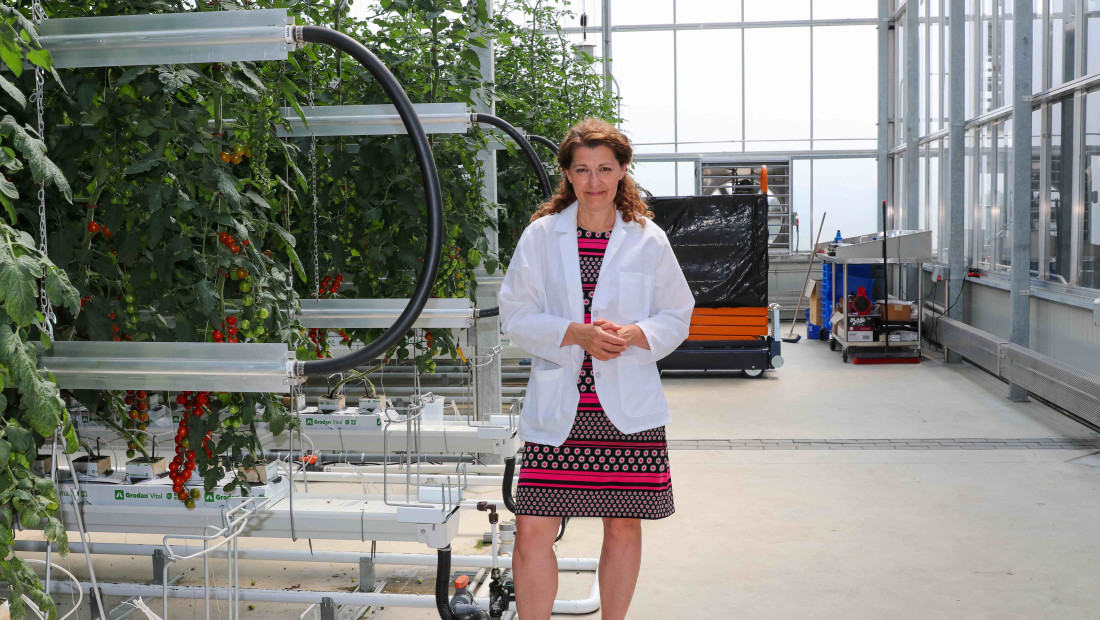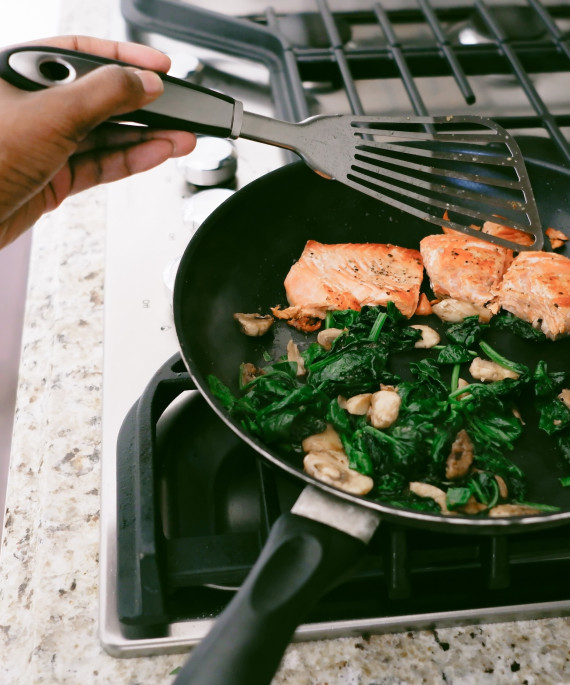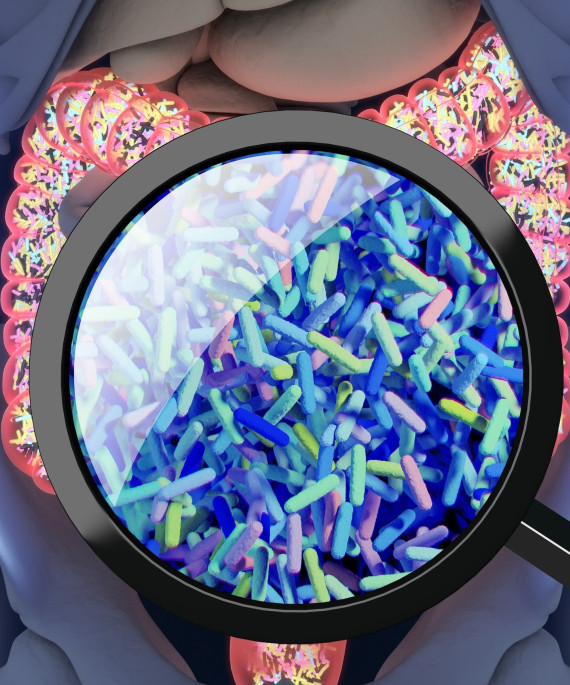
Associate Professor Sanja Ilic in the Controlled Environment Agricultural Research Complex, where she will do a new study on hydroponics in the facility’s new Biosafety 2 greenhouse lab.
Across Ohio and the nation, thousands of warehouses and greenhouses glow with LED and high-pressure sodium lights. Vegetables suspended on platforms dangle webs of roots into water fortified with nutrients. Stacked vertically or sometimes stretched across acres-wide greenhouses, the systems grow leafy greens, tomatoes and other crops without a modicum of soil, like futuristic space farms in sci-fi flicks.

But hydroponic growers have been around for decades. In 2023, about 2,290 hydroponic crop-growing businesses operate in the United States, employing thousands of workers and supplying locally grown produce to millions. Chances are, at least part of the restaurant salad you munched on for lunch, or the herbs you bought at the grocery, were grown indoors using hydroponic technology.
“Hydroponic production has really taken off,” said Sanja Ilic, associate professor of human nutrition in the College of Education and Human Ecology. “Just in Ohio, we have a number of new producers from small greenhouse facilities all the way up to really large leafy green producers.”
Consumers might think that — minus the soil and outdoor exposure — hydroponic crops are not at risk for being contaminated by pathogens such as salmonella, listeria and E. coli. But that’s not the case, said Ilic, who has done multiple studies on food safety. This fall, she will begin a nearly $1 million study on reducing food-safety risks for hydroponically grown leafy greens.
“There's a lot of misconception that hydroponics are safer than field-grown crops, but the risks are also present in hydroponic,” she said. “It's just different types of risks.”
For the next four years, Ilic will work to identify how pathogens act when introduced to nutrient film systems, one of the most common types of hydroponic growing. Working with Melanie Lewis Ivey, associate professor in the Department of Plant Pathology, Ilic will conduct the research in a state-of-the-art, Biosafety Level 2 greenhouse lab, slated to open in September inside a research complex at Ohio State’s Waterman Farms.
A growing option for growing produce
As the American population increases, so does the demand for healthier produce. At the same time, erratic weather and global warming make cultivating certain crops difficult. That’s where hydroponics, or indoor farming, come in, with controlled lighting, humidity, temperature and nutrient enrichment. Crops go from being seasonal to year-round but can still be marketed as local.
“With the controlled environment, you can overcome some of the climatic challenges,” Ilic said. “And we're headed into more and more issues with climate change and water preservation. With sustainability in mind, it is not unexpected that hydroponic production is going to skyrocket.”

The U.S. market for indoor farming, in fact, is expected to reach more than $32 billion by 2028, growing at a rate of 9.7% annually. But the idea that hydroponic produce is “sterile” or somehow “pathogen-free” is a misconception, Ilic said.
A salmonella outbreak in 2021, traced to a hydroponic greenhouse in a small, Illinois town, sickened 31 people. The exact cause remains unknown, but a contaminated stormwater basin might have contributed, a report by the U.S. Food and Drug Administration found.
“When plants are grown outdoors, irrigation water is also a huge risk factor,” Ilic said. “(With hydroponics) it’s just that the irrigation water is introduced to the plants in different modes.”
The nutrient film technique uses shallow, plastic channels called lanes, which plants rest upon. Water fortified with phosphorus, nitrogen and other nutrients flows through the lanes, circulating over the plant roots. Another method — deep water culture — suspends floating rafts of plants over pools of nutrient-rich water.
“Here we have plants sitting in the water. Anything that is in water is going to have a huge potential for contaminating a plant, even when we grow produce outdoors. The water is a great medium to move pathogens from point A to point B,” Ilic said.
Pests and animals that breach the facility can contaminate plants also, as can workers handling the plants. But as the Illinois contamination showed, water represents one of the biggest risks for spreading viruses and bacteria.
Ilic’s and Ivey’s study, funded by the USDA’s National Institute of Food and Agriculture, will research how biofilms — layers of bacteria or other microbes —are created within the growing systems. “How can we interfere to either eliminate these biofilms or to prevent them from creating in the first place?” Ilic said.

Of particular interest will be the persistent algae mats that can form in hydroponic systems — a huge headache for growers. The researchers will observe what happens when they introduce listeria and salmonella to the algae. The Columbus campus’ new Biosafety Level II greenhouse lab — among the few research greenhouses cleared to study pathogens in the country — will allow them to do so safely.
“We're going to evaluate the influence of algae in the creation of that biofilm,” she said. “Is algae protective or is it contributing to these biofilms? Are biofilms looking differently? (Are they) structured differently because there’s algae present in a system?”
A study like this has never been conducted, she said. But given the rapid growth of hydroponic farming worldwide, it needs to be.
“The very same conditions that are conducive to year-round production” — warm and wet environments — “are also conducive for the growth of microorganisms and contamination,” she said.
“We want to understand how the biofilms create when we have algae in the environment — how listeria and salmonella grow within these complex biofilms and what can we do to prevent it,” she said.
While mitigating foodborne illness is a priority, making food microbe-free is unrealistic, she said.
“We need to understand, as consumers, there is no such thing as zero risk,” she said. “These products are not sterile, and we don't even want them to be sterile. But we do need that certainty that the product that we are consuming is not contaminated with a dangerous pathogen.”
Once the study is complete, the researchers will work with growers to implement safety procedures based on what they find.
But how nutritious are hydroponic crops?
Some traditional, “soil” farmers and chefs contend that removing dirt can’t possibly produce food as nutritious as traditionally grown fruits and vegetables. The soil — a complex mix of minerals and organic matter — is just too valuable in the fortifying process, they say.
In fact, few if any studies have considered how growing plants sans soil impacts their nutritional value. Ilic’s study will.
“We uniquely integrate nutrition research in our food safety hydroponic studies,” Ilic said.
How do sanitizers used in growing systems impact nutrients? Do water treatments lead to loss of nutritional quality?
“We are looking into...how they affect human nutrient concentrations and quality of the crops: Carotenoids, phytochemicals, stuff like that,” Ilic said.
How a food safety scientist prepares a salad: Tips for staying safe
A food safety researcher might seem like the last person who would eat the very substances she studies in the lab. (A friend once told her that “food-safety freaks” should eat alone, after she bugged him too many times about potential dangers on his plate.) But Ilic does eat leafy greens, and quite frequently.
“Fresh, crispy lettuce is always appetizing to both me and the family,” she said. “We’re big on lettuce and probably serve it in a salad on a daily basis.”
Her tips for staying safe:
- Ilic rinses her leafy greens under running water, even those labeled “triple washed.” Commercial rinse agents are not proven to remove pathogens; Ilic doesn’t use them.
- Keeping leafy greens cold is very important. Never leave them in the car for longer than the trip from the grocery store. Bacteria love warm environments, between 40 and 140 degrees Fahrenheit. If any pathogens are present, heat will make them multiply.
- Don’t leave salad sitting out while you prepare other foods or wait for your family to show up to the table.
- “It is important that you do not allow (leafy greens) to be in a temperature danger zone…,” Ilic said. “Don't take it out of the fridge, put it in a bowl, then let it sit on the counter to warm up. Make sure that you refrigerate it at all times.”
- Summer picnics are breeding grounds for the kinds of pathogens Ilic studies.
- Keep salads and greens in a cooler until eating, then cover them and put them on ice.
- If it’s really hot — more than 90 degrees — leafy vegetables and other foods are safe for just one hour outside the fridge or cooler.
- Speaking of coolers, fully packed ones keep food colder and safer longer than half-full ones.
- Top off space in the cooler with extra ice and keep drinks in a separate cooler from perishables.
- No repeated opening and shutting, which warms the food inside. Keeping the cooler shut keeps at bay the meanie greenies — those nasty little microbes that can make you sick.




